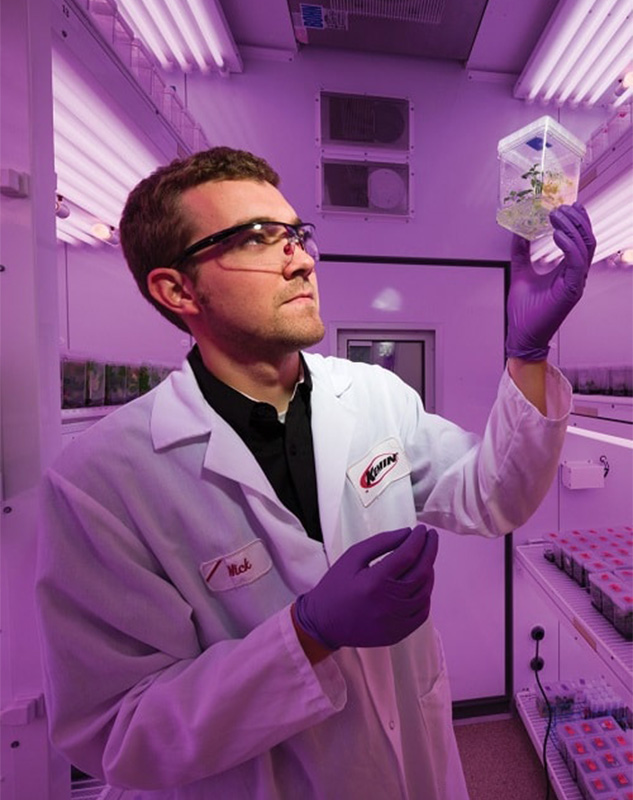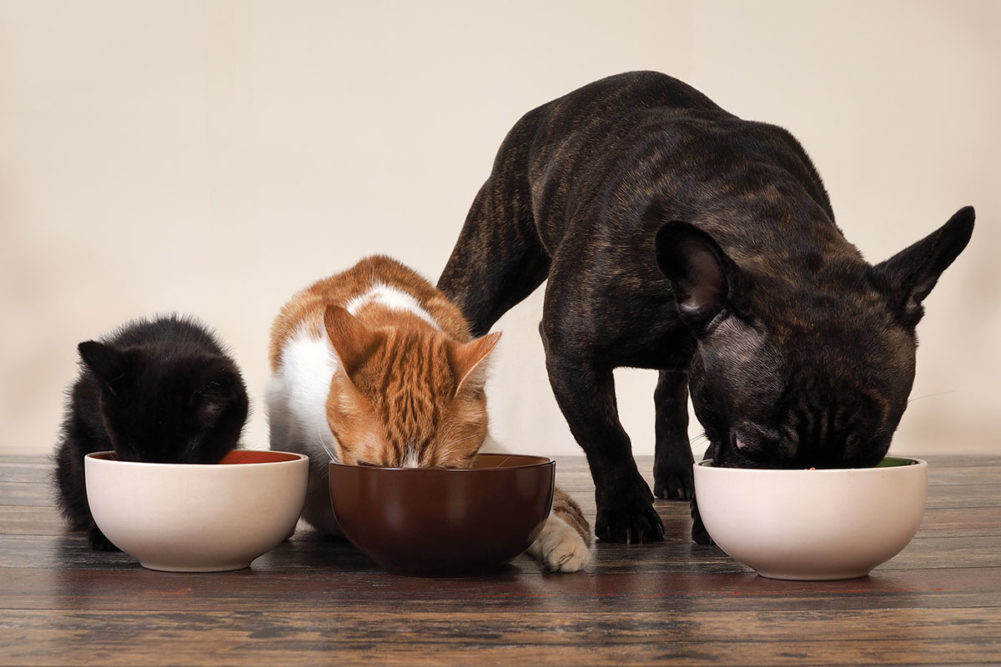This article was published in the May 2023 issue of Pet Food Processing. Read it and other articles from this issue in our May digital edition.
Pet food manufacturers understand that appealing to a pet’s natural taste instinct is one of the main keys to creating an enjoyable eating experience — which is why palatants, or flavor enhancers, are applied to pet foods to improve their inherent palatability and increase pet acceptability.
Today, there are a wide variety of palatants available for pet food and treat formulations designed to help satisfy the pet both through taste and nutrition. However, palatants are designed with specific food formats in mind — a palatant designed for wet cat food will function differently than one designed for a cat kibble or treat.
What’s trending in palatability mirrors what’s trending in food, according to industry experts. For example, sustainable sourcing has become more prevalent in recent years. Non-meat options are also a big topic of discussion; they perform just as well as meat-based palatants but can be more sustainable and used across multiple chassis.
Supply assurance is a big theme among manufacturers as well. Ingredients that are difficult to source — such as unique animal proteins — have become less favored since the pandemic.
Alana Brown, manager of customer engagement for Applied Food Biotechnology International (AFB), a global manufacturer of pet food ingredients based in St. Charles, Mo., noted that the company designs its palatants with ingredients and processes that appeal to one or more of the pet’s sensory capabilities to ensure their feeding experience is enjoyable.
“We ask pets to share their opinions via their feeding behavior,” said Alana Brown, AFB International.
“How do we know? We ask pets to share their opinions via their feeding behavior,” Brown said. “We measure how much they eat, how readily they eat, and how they behave when they eat. We use this data to make product selections and design new products that will appeal to pets, their owners and pet food companies.”
Abby Castillo, senior global product manager of palatants and health & nutrition at Kemin Nutrisurance, headquartered in Verona, Mo., noted the first step in creating an enjoyable feeding experience for the pet is to understand pets at a biological level.
“When we understand the biological, species-specific aspects that drive palatability, we are better able to develop solutions to appeal to dogs or cats,” Castillo said. “Some of the biological differences are well-known or easily observable.”
For example, dogs are omnivores that eat one to two large meals a day and cats are obligate carnivores that eat small, frequent meals throughout the day.

There is no “one-size-fits-all” formula when it comes to pet food palatability. Palatant systems need to be tested to determine how the kibble matrix, fat and palatant interact.
|“Others require significant testing and/or experience to discern — like specific preferences for certain kibble shapes, hardness, texture or moisture in a finished diet, or type and concentration of aromas or flavor ingredients delivered to the outside of the kibble via a palatant,” Castillo said.
Evolving enhancers
One of the most interesting aspects of palatability is that there is no “one size fits all” palatant. The quality, flavor profile, texture and stability of the kibble matters to overall palatability. Palatant systems work best when enough time and resources are devoted to finding the right system for a particular kibble that also matches with the desired claims.
“Similar to how we as humans may prefer specific combinations of flavors — such as gravy on mashed potatoes or chocolate sauce on ice cream — so, too, do pets have preferences, and the interaction between kibble matrix, fat and palatant matter,” Castillo said.
Trevor Faber, Ph.D., joined Highland, Ill.-based Trouw Nutrition in 2015 as a companion animal nutritionist and has seen research and interest in the better understanding of palatants grow tremendously through the years.
Trouw collaborates with a myriad of ingredient manufacturers to understand the advantages and disadvantages of their products as a palatability enhancer, and utilizes its broad ingredient portfolio to select the best option for the product it is formulating for customers.
Faber explained there’s a lot that must happen behind the scenes to get things right.
“When we understand the biological, species-specific aspects that drive palatability, we are better able to develop solutions to appeal to dogs or cats,” said Abby Castillo, Kemin Nutrisurance.
“At Trouw, we formulate supplement blends and toppers that contain bitter and sour tasting ingredients that often are not appealing to pets, but serve an important nutritional purpose (e.g., vitamins, minerals, select functional ingredients),” he said. “To drive acceptance, we utilize a myriad of strategies to overcome these negative odors and flavors and create a product that is both appealing and nutritious to the animal. We do this by understanding the profile of the supplemental nutrients and then formulating a flavor profile that is capable of overcoming any off-flavors and odors.”
That can range from yeasts and protein products to commercial palatant products. The team will then have conversations with its customers about cost limitations and also palatability targets, noting there is definitely a tradeoff between cost and performance.
“Customers don’t come to us as a palatant supplier, but they do expect when we create supplements and toppers for them, they will be accepted by the pet,” Faber said. “This leads to questions on the format and performance of the final product (e.g., powder or soft chew, stand-alone supplement or topper for food). From there, we will design a palatant system that matches those needs.”
Pet food manufacturers expect continuous improvement in their palatant systems to gain and maintain market share and provide the most appealing pet food products to consumers and pets. Innovation in palatability is key to meeting this demand for better and/or lower cost products.

Kemin has a global R&D team that works with pet food processor customers to formulate the most suitable ingredients to meet their needs at the time.
|“This expectation for improvement, coupled with the growing diversity of pet food flavors, formats and specific claims — like natural, limited ingredient or no added grain — have spurred the development of new ingredients and new technologies to meet these needs,” Castillo said. “When pet food products were less diverse, palatant companies could offer a smaller portfolio and meet most of their customers’ needs. Now, a more comprehensive, yet broad and diverse portfolio is required to meet their demands.”
By design
Palatant technology continues to evolve together with advancements in pet nutrition and changes in food trends. Manufacturers are applying discovery and innovation to formulations, processes and ingredients to ensure that palatants meet the needs of today’s pets and pet foods.
For example, AFB provides palatants that are designed to be applied internally or topically coated on a kibble or treat.
“Having this flexibility is ideal when a manufacturer’s coating options are limited due to diet type or equipment,” Brown said. “We have palatants with functional ingredients like probiotics that can be used topically. When a functional ingredient is mixed with a palatant, it can improve operational efficiency, efficacy and save cost for the pet food company.”
AFB’s portfolio of palatants is formulated to deliver optimal performance and fit each customer’s unique needs.
“Every customer is different,” Brown said. “Brands within a customer portfolio have different requirements. We tailor our palatants to fit each individual need. We have a collaborative team involving multiple departments that work closely with our customers.”
Some of Trouw’s customers will take their supplement blend and add additional animal proteins and palatants, In these instances, the company will add very few palatability-enhancing ingredients. Other customers will take their blend and just repackage it.
“A reoccurring challenge we face is creating a palatant system that matches the customer’s marketing goals,” said Trevor Faber, Ph.D., Trouw Nutrition.
“We need to incorporate the palatant system with their supplemental ingredients for those products, and we’re expected to have it perform,” Faber said. “A reoccurring challenge we face is creating a palatant system that matches the customer’s marketing goals. To meet the customer’s objectives, we’ve had to identify vegetarian, non-GMO and other related palatability-enhancing ingredients.”
A winning partnership
AFB regularly attends trade shows and has a research and development pilot facility where it works on collaborative projects with its customers.
“Collaboration is key to win-win projects,” Brown said. “We have regular touch-bases with customers and seek feedback on their needs and what’s changing on their end. Are they looking to drive out cost? Are they looking to premiumize? We are constantly developing solutions to have something ready as the need arises.”
AFB also offers “teach and learn” sessions with pet food companies. Companies bring in multiple departments and the team talks about what palatants are, how they are applied, how palatability is measured, and how they can use palatants to differentiate their brands.
“The sessions are highly interactive where lots of questions are asked and new ideas are sparked,” Brown said. “These sessions are great for new and cross functional employees. We enjoy these sessions too because we learn what’s important for that customer and we can plow that insight back into our product development and strategy.”

It doesn’t matter how nutritious a pet food is — if the dog or cat won’t eat it, the nutrition is lost.
| Source: ©ANOUSHKATORONTO – STOCK.ADOBE.COMKemin utilizes diverse flavor technologies within its product portfolio, so if a customer needs a different solution, they can partner closely to optimize based on palatability, cost or label targets.
“Kemin also has a commitment to discovery research and innovation which leads to new flavor technologies for use in palatant formulations,” Castillo said. “We have customers of all sizes across the world. We ensure support to our customers with our global manufacturing footprint, which includes locations on three continents. We also have a global R&D team responsible for innovative discovery work, as well as R&D teams in each region to develop and adapt portfolios to meet local needs.”
Pet food market trends can provide unique challenges or opportunities to the palatant supplier, which may require innovative solutions to provide an appealing product.
For example, with lasting effects on the supply chain from the pandemic and global conflicts, there is an increased desire for more diverse ingredients.
“One of the ways Kemin has responded to this trend is with our P Series line of plant-based palatants,” Castillo said. “These palatants are compatible with conventional, vegetarian or limited-ingredient pet food labels. These palatant formulations utilize plant-based protein instead of an animal-based protein, so they are not at risk of animal disease outbreak and have fewer export restrictions.”
Despite the new palatant options and varieties processors can incorporate into their product formulations, one thing remains clear — no trend is prioritized over the need for pets to be drawn to the food in their bowl.
Read more about product development, ingredients and formulation.



